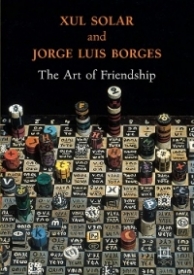Xul Solar and Jorge Luis Borges: The Art of Friendship
On view:
through
Xul Solar and Jorge Luis Borges: The Art of Friendship
Xul Solar and Jorge Luis Borges: The Art of Friendship is an exhibition that explores friendship as a cosmopolitan agency, which informed Argentine art and culture through the intellectual exchange between the mystic artist Xul Solar (1887-1963) and the writer Jorge Luis Borges (1899-1985.) The Art of Friendship focuses on the fraternal dialogue and collaborations between Solar and Borges, the most singular cultural figures in Buenos Aires in the twentieth century who contributed to the philosophical and aesthetic renewal in Argentina in the 1920s by cultivating a form of “fluid nationalism.” The exhibition is curated by Gabriela Rangel, Director of Visual Arts and Chief Curator at Americas Society with the collaboration of poet Lila Zemborain and the assistance of Christina De León and Anya Pantuyeva. It will be on view from April 18 through July 20, 2013 travelling in the fall to the Phoenix Art Museum. For Gabriela Rangel, “Xul Solar and Jorge Luis Borges were central to the process of invention of a local universal identity, which seems paradoxical, but is rather extraordinary and unique.”
The exhibition covers over forty years of friendship between Solar and Borges, who met after their return from Europe in 1924, in the literary and artistic circles of the journal-magazine Martin Fierro and collaborated on different projects until Solar’s death in 1963. In the search of a new Argentine avant-garde identity, Borges and Solar, along with other martinfierristas developed a Neo-Creole identity that fused the tactics of the European modernists with nationalist ideas and the gaucho vernacular culture. Nonetheless, each developed distinct voices within this group: Borges reinventing the slums and unpaved streets of Buenos Aires’ suburbs, and Xul creating new languages Neo-Creole and Pan-Language as well as fantastic landscapes filled with monstrous figures in which he blended mystic and occult references with Pan-American symbolism. As Sylvia Molloy has suggested, Borges and Solar seek difference rather than assimilation acting as born-exiles in an environment of fervent avant-garde debates and nationalisms. Both constituted a visual metaphor that built the core for this new conception of the local cosmopolitan self. During their countless walks around the city, chess games, and while listening to music the two discussed the poetry and art of William Blake, the mysticism of Emanuel Swedenborg, theology of angels, German Idealism, and non-Western religions and languages. Borges and Solar forged a lifetime friendship while discovering and contributing to the identity of Buenos Aires in the process of the invention of their own.
The Art of Friendship departs from a speculative lineage on friendship construed by thinkers such as Aristotle, Cicero, Michel de Montaigne, Friedrich Nietzsche, Ralph Waldo Emerson, Richard Rorty, Hans-Georg Gadamer, and Jacques Derrida who have examined fraternal exchange as an instance of civic agency. Friendship is also considered as a space of social and political interaction, which enables the tracing of genealogical maps that identify vast networks of solidarity and communities.
The show gathers an important number of paintings, first editions, and manuscripts—some of which have never left Argentina—as a means to explore the intellectual nature of the relationship between Solar and Borges and the definition of friendship at large as a private agency with public effects. Xul Solar and Jorge Luis Borges: The Art of Friendship is organized by Americas Society with the collaboration of Museo Xul Solar in Buenos Aires. It is accompanied by a fully illustrated catalogue with contributions by Patricia Artundo, Sergio Baur, Maria Kodama, Gabriela Rangel and Sylvia Molloy, in addition to a plaquette with original poems by Monica de La Torre, Cecilia Vicuña, and Lila Zemborain inspired by Solar’s astral voyages or San Signos.
Xul Solar y Jorge Luis Borges: El arte de la amistad en Americas Society revela el vínculo inédito entre dos importantes figuras de la Argentina del siglo XX.
Opened through July 20, the exhibition focuses on the fraternal collaborations between Solar and Borges, which contributed to the philosophical and aesthetic renewal in Argentina during the 1920s.
Xul Solar y Jorge Luis Borges: El Arte de la Amistad en Americas Society plasma el intercambio intelectual entre ambos artistas, que fue fundamental en la construcción de una identidad cultural argentina.
Xul Solar and Jorge Luis Borges: The Art of Friendship at Americas Society explores the not-yet fully recognized singularity of the mystic artist and his intellectual affinity with the Argentine writer.
Xul Solar and Jorge Luis Borges: The Art of Friendship is made possible by the generous support of the Ministry of Culture of the Government of the City of Buenos Aires, Aeropuertos Argentina 2000, the Diane and Bruce Halle Foundation, Erica Roberts, Alejandro Quentin, Eduardo Grüneisen, Fundación Rozenblum, and Veronica Zoani de Nutting. In-kind support is graciously provided by Arte al Día.
The Spring 2013 Visual Arts Program is also supported, in part, by public funds from the New York City Department of Cultural Affairs, in partnership with the City Council.
AS/COA is proud that this program is part of New York City's 10th Annual Immigrant Heritage Week.















